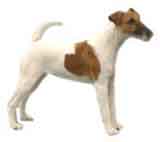Small Dog BreedsInformation About The Smooth Fox Terrier Dog Breed |
|
|
The Smooth Fox Terrier has a strong, athletic body. Many agree that he is the smartest of the terrier breeds, second to none in killing vermin and bolting fox. He is an alert, smart, amusing, lively, and independent breed. The Smooth Fox Terrier is an excellent working dog and makes an intelligent pet. He is a sturdy clean little dog with a lot of spirit and personality, able to fit into any lifestyle if given a fair chance. He is easily trainable. Because of his terrier instinct, this dog loves to bark. Digging is also a natural talent which needs to be expressed. He has a tendency to be feisty and defiant at times. The Smooth Fox Terrier has a higher than normal prey drive for a terrier and may be very aggressive toward other dogs. He is suspicious of strangers and does not quickly warm up to them. This breed may not be tolerant of small children. He can be easily distracted, and it is often hard to focus his attention, particularly when other animals are present. Training should start early and be consistent and firm. "Down" and "Come" commands are often difficult to teach this stubborn, willful breed. Socialization is crucial as soon as possible; you need to start introducing him to people and dogs from puppy hood. Spoiling may create a pushy, dominant dog that uses biting to get his way. Unlike other terriers, the Smooth Fox loves to retrieve. Use this method to get his attention as well as a constructive exercise. Size: The Smooth Fox Terrier stands 14-15 ½ in at the shoulder and weighs between 15 and 20lb. History and origin: This breed was used in England in the 18 th century as a bolter of fox and as a ratter. It is believed that various breeds such as Greyhound, Beagle, Wire Fox, and Bull Terrier were used in the development of the Smooth Fox. The breed made his first debut in show ring in 1862 at the Birmingham, England National Dog Show. Feeding: Recommended feeding for this breed would be ½ - 1 can of high quality meat product (13.3oz size) with biscuit added in equal amount or 1 ½ cupfuls of a complete dry food. Exercise: The ideal home for this highly active breed is a house with fenced yard, though an apartment is adequate as long as he is getting his daily exercise. Several walks a day is necessary for this breed as well as occasional runs. Grooming: This breed has a smooth, short, and shedding coat that requires daily brushing using a stiff brush. Trimming is required a few weeks before a show, paying particular attention to the inside and outside of ears, jaw, and muzzle. Back to the Small Dog Breed page
| |
|
Related News About Dogs ' ); // get rid of newsfeed display by carp CarpConf('poweredby',''); CarpCacheShow('http://www.small-dog-info.com/support-files/rss.xml'); ?>
|
|
|
|
|
|
Copyright © 2006-2007 dogguidance.com |


